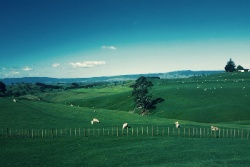There is no easy or speedy solution to remove the algal bloom issues plaguing Lake Hood in Canterbury.
The Ashburton District Council isn’t about to rush into spending ratepayer money on potential solutions without thoroughly investigating its options first, the chief executive says.
A 75-page report at the council meeting on Wednesday provided an update on the water quality issues at Lake Hood and the work underway to address them.
Lake Hood has been closed since April 3 due to health warnings. The council's decision to close the lake came after two people were poisoned by the toxic algae.
Council chief executive Hamish Riach said the council has called in the leading cyanobacteria scientist in New Zealand in Lincoln University-based Professor Susie Wood to lead the investigative work towards a solution.
Wood has already had a site visit and is proposing modelling the way the water moves around the lake and trials of some potential solutions, Riach said.
“It’s a complex issue, and there is no silver bullet.
“There is no one thing anyone can do to solve the cyanobacteria issue, but there is a whole lot of things that we might be able to do if we can prove that they are the best things to do.”
He said people want to isolate the problem down to one factor.
“It’s Carters Creek, or it's the intake, or it's the box culvert, or it's the something else.
“All those things are likely to be part of the problem that has built up.
“Fixing any one of them is unlikely to make any material difference because it’s a whole smorgasbord of issues.”
The council doesn't want to just be "jumping at shadows”, but rather look at the whole picture, he said.
Riach summarised the report by saying the council will model water flows and trial some solutions.
Infrastructure and open spaces group manager Neil McCann said an update on the plans for the research and the trial tests would come to the council in a couple of months.
He said the students undertaking the work already have funding and the council will contribute to travel costs and infrastructure for the tests, which is covered within existing budgets.
The council is also considering future options for increasing water flows into the lake, including the feasibility of applying for a short-term, non-consumptive take.
There were suggestions of diverting water from the stockwater network, which the council is planning to exit by July 2027, back into the river to boost flows and have more water flow into the lake.
Riach said it’s not that simple.
“Us surrendering water back to the river doesn’t automatically mean it flows into Lake Hood.”
Updates on the progress will be reported back at the six-weekly activity briefing meetings.
Meanwhile, the lake’s water level was lowered this week to allow for winter flushing and maintenance work.
“Flushing simply means letting old water out and new water in, and maintenance can be carried out on boat ramps and banks while the lake is low,” Riach said.
- LDR is local body journalism co-funded by RNZ and NZ On Air.



 Gordon Campbell: On New Zealand’s Peter Thiel Problem
Gordon Campbell: On New Zealand’s Peter Thiel Problem Greenpeace: Gore’s Iconic Brown Trout Statue Latest Victim Of Township’s Drinking Water Crisis
Greenpeace: Gore’s Iconic Brown Trout Statue Latest Victim Of Township’s Drinking Water Crisis Environmental Defence Society: Another Offensive Launched In The Government’s War On Nature
Environmental Defence Society: Another Offensive Launched In The Government’s War On Nature Office of Ethnic Communities: New Zealand’s Muslim And Jewish Organisations Join As Signatories To The Harmony Accord At Government House
Office of Ethnic Communities: New Zealand’s Muslim And Jewish Organisations Join As Signatories To The Harmony Accord At Government House ICONZ: Government Faith Initiative Misaligned, Say Groups Who Declined To Join
ICONZ: Government Faith Initiative Misaligned, Say Groups Who Declined To Join NZ Police: Cha-Ching - Police Seize Thousands Of Dollars In Fake Bills
NZ Police: Cha-Ching - Police Seize Thousands Of Dollars In Fake Bills Rural Women New Zealand: 100 Years Of Service
Rural Women New Zealand: 100 Years Of Service


